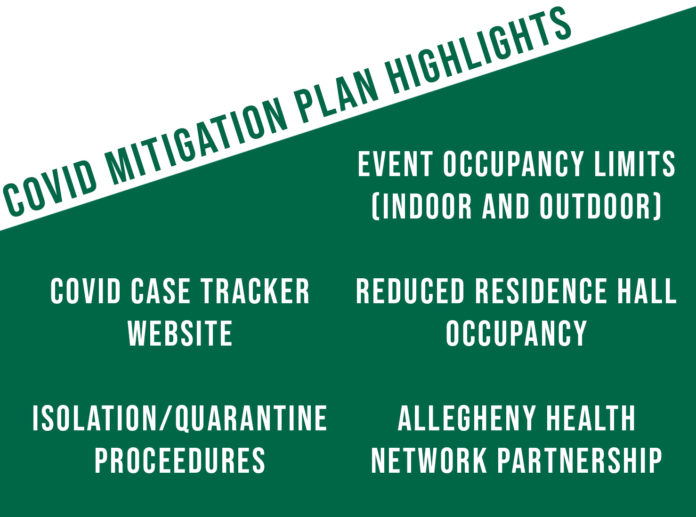As SRU students prepared to resume classes, SRU administration worked to create guidelines and structures to navigate our “new normal” this fall semester.
SRU administration released its initial plans on July 15 for students to return to campus for the fall semester. While the reopening plans have been continuously updated, the guidelines outline strategies for campus life, mitigation, monitoring campus and communications.
Self-reporting and contact tracing
When someone who is reporting to campus starts to experience symptoms or has a confirmed case of COVID-19, students are to contact the Student Health Center and faculty and staff members are to contact Human Resources. Those resources will instruct callers on the next steps to take, which may include testing.
When an SRU community member tests positive for COVID-19, the university performs an initial case investigation, initiating the contact tracing process. The community member would be asked questions about where they were on campus. The university then shares this data with the Pennsylvania Department of Health.
After the initial case investigation, the Pennsylvania Department of Health takes over the investigation, which includes contacting any people who were associated with the positive case.
Contact tracers will contact any close contacts and instruct those people on what next steps to take based on the specific circumstances of the association, according to Paul Novak, executive director of planning and environmental health and safety.
“They would simply follow the health department guidelines, and we would be ready to assist them in whatever way that we possibly can,” Novak said.
Trends over numbers
An emergency COVID response team, comprised of Novak, Windy Stafford (director of emergency management), Provost Abbey Zink and representatives from university communications and public affairs, facilities, the President’s office, human resources and student affairs, meets daily to discuss the ongoing emergency.
Novak said that SRU’s mitigation strategy largely relies on trends rather than the exact number of SRU community cases. Other factors that influence the university’s plan include campus resources, employee call-off rates and absenteeism.
“All our plans, guidance, protocols, should be considered a ‘framework’ to assist the campus in mitigating the ongoing public health emergency,” Novak said in a follow-up email statement. “And as much as we would all like to, the reality is you cannot ‘script’ an emergency response. There are no protocols to follow in any given order; do step #1, go to step #2, step #3 and so on. We have to be ready to respond to the circumstances and conditions as they present themselves.”
Novak identifies this need as the reason for SRU’s partnership with Allegheny Health Network, which assists with identifying these trends.
“It’s about the trends, it’s about incident rates and infection rates or mortality rates,” Novak said. “That’s partially why we engaged the Allegheny Health Network, because to have them help us monitor these data metrics and identify trends, we would have to look at what the incident rates are on campus in comparison to Butler County as a whole.”
Novak added that it is more likely for the campus to gradually close select buildings or services compared to a sudden shutdown of campus, such as what happened during March.
Isolation and quarantine procedures
On SRU’s COVID case tracker website, all student, faculty and staff positive cases are listed. This number only counts cases in which the person reported to campus within the past 14 days. As of Sept. 3 at 4:45 p.m., 36 students have tested positive.
While SRU notified the community when the university was notified of the first positive case, they are using this website to update the number of cases.
When a student who is exhibiting symptoms and/or tests positive for COVID-19 contacts the health center, they would be asked to isolate. However, if a student is not exhibiting symptoms but was in contact with someone who may have had COVID-19, they would be asked to quarantine. Both isolation and quarantine are a 14-day period unless a negative test result reverses the need to social distance.
Because there are fewer residents on campus, Novak says that on-campus residents are able to be isolated or quarantined in their own room since students are assigned to their own bedroom.
“If the numbers would increase to an unmanageable point, there might be a decision made to relocate all of these people at a certain point in time into a particular building simply for ease of management and all of that,” Novak said.
Building F, as well as North Hall and Rhoads Hall, the two traditional dorms on campus, are not housing students this semester.
For on-campus residents, food delivery will be arranged, but the Student Health Center will arrange phone calls to check on students daily. While the university does not hold as much jurisdiction for off-campus residents, telehealth is still available, but off-campus students would be responsible for their own meals and for isolating or quarantining.
Citing privacy concerns, Novak declined to state how many of the student positive cases are on-campus or off-campus residents.
Campus life and in-person events
In-person events, which are defined as events on or off campus with 11 or more people, are permitted this semester, but with restrictions.
This semester, up to 25 people are permitted for an indoor event, and up to 40 people can attend an outdoor event. Outdoor events are encouraged when possible.
According to Lauren Moran, director of the office for student engagement and leadership, said that these restrictions apply on campus and off campus when a university group is organizing the event.
“If somebody hosted an event, a student organization or department off campus, the guidelines still apply because they’re still representing the university and we wanted to keep that mitigation effort consistent both on or off campus,” Moran said.
Moran said that there were conversations to consider allowing in-person events at all. However, guidelines were created to allow in-person events the opportunity for people to engage in person if they wish.
“We know people are going to want to engage in person, we know that people are going to do it anyway, and so instead of putting this blanket statement on, we wanted to develop ways for people to safely [meet],” Moran said. “We wanted to create opportunity for people to still engage together in person.”
Moran and Deb Schell, director of the student center and conference services, oversee the COVID-19 In-Person Events Training events, which is required of any organization that anticipates hosting in-person events this semester. The trainings go over the guidelines for events and demonstrate how to track attendance on CORE, a requirement for in-person events this semester.
As part of the other restrictions on in-person events, face covers are required, no external guests outside the university are permitted and no food is permitted unless ordered through AVI Dining.
Some examples of in-person events so far this semester are an outdoor movie series on the quad hosted by the Student Government Association, a grab-and-go lunch pick up for Honors College students and an outdoor scavenger hunt organized by the Women’s and Pride Centers.
Performing arts groups and club sports are not permitted to host any in-person activities due to the vocal projection and heavy breathing affiliated with these activities. Groups that earn academic credit, such as the Marching Pride or similar music groups, are required to follow the guidance of the academic department.
Moran encourages groups in these categories to do virtual events if possible and offered to meet with these groups to discuss virtual alternatives, but she understands that some are disappointed by this decision.
Students can view all in-person and virtual events on CORE and can RSVP accordingly.








